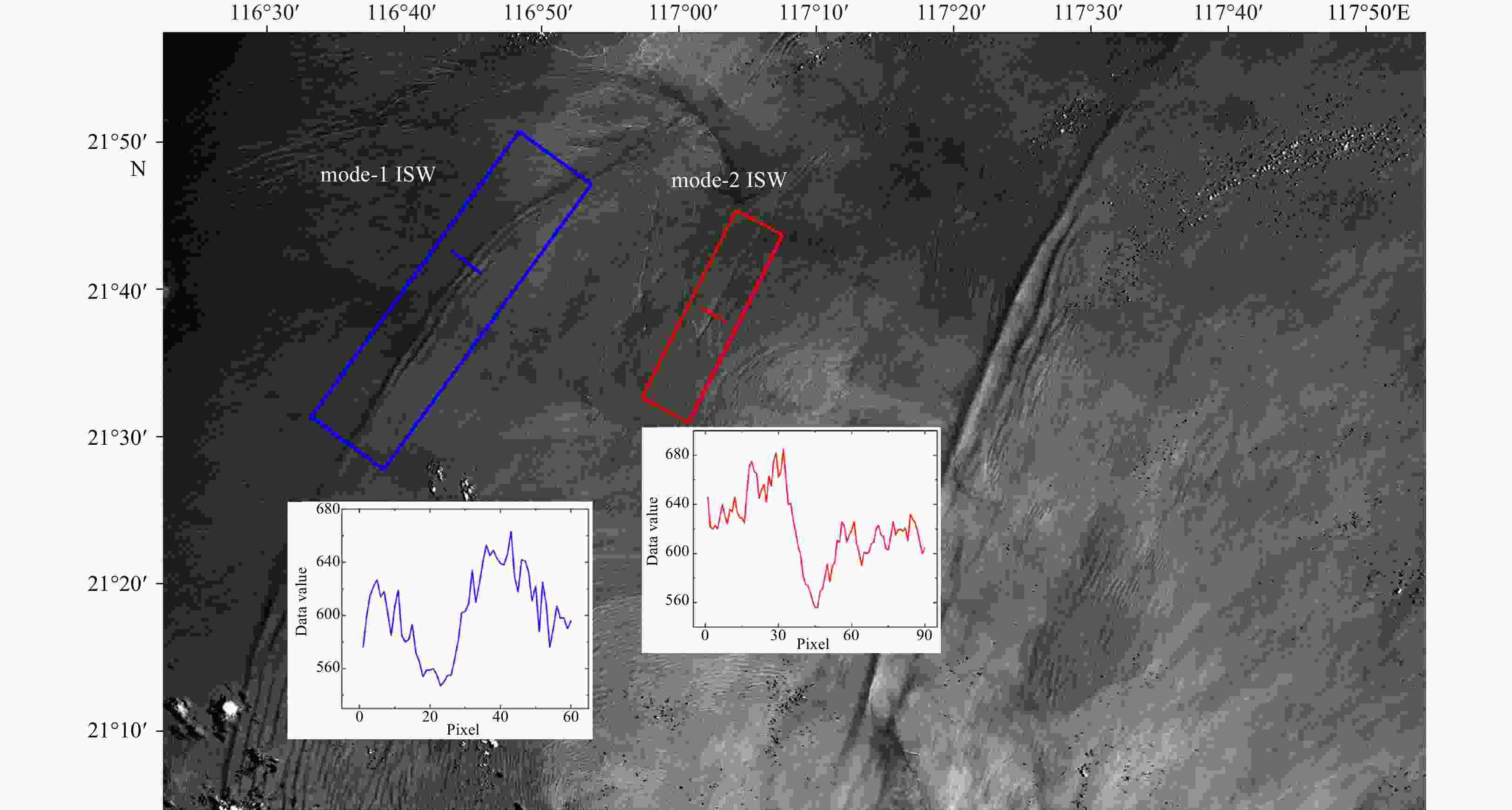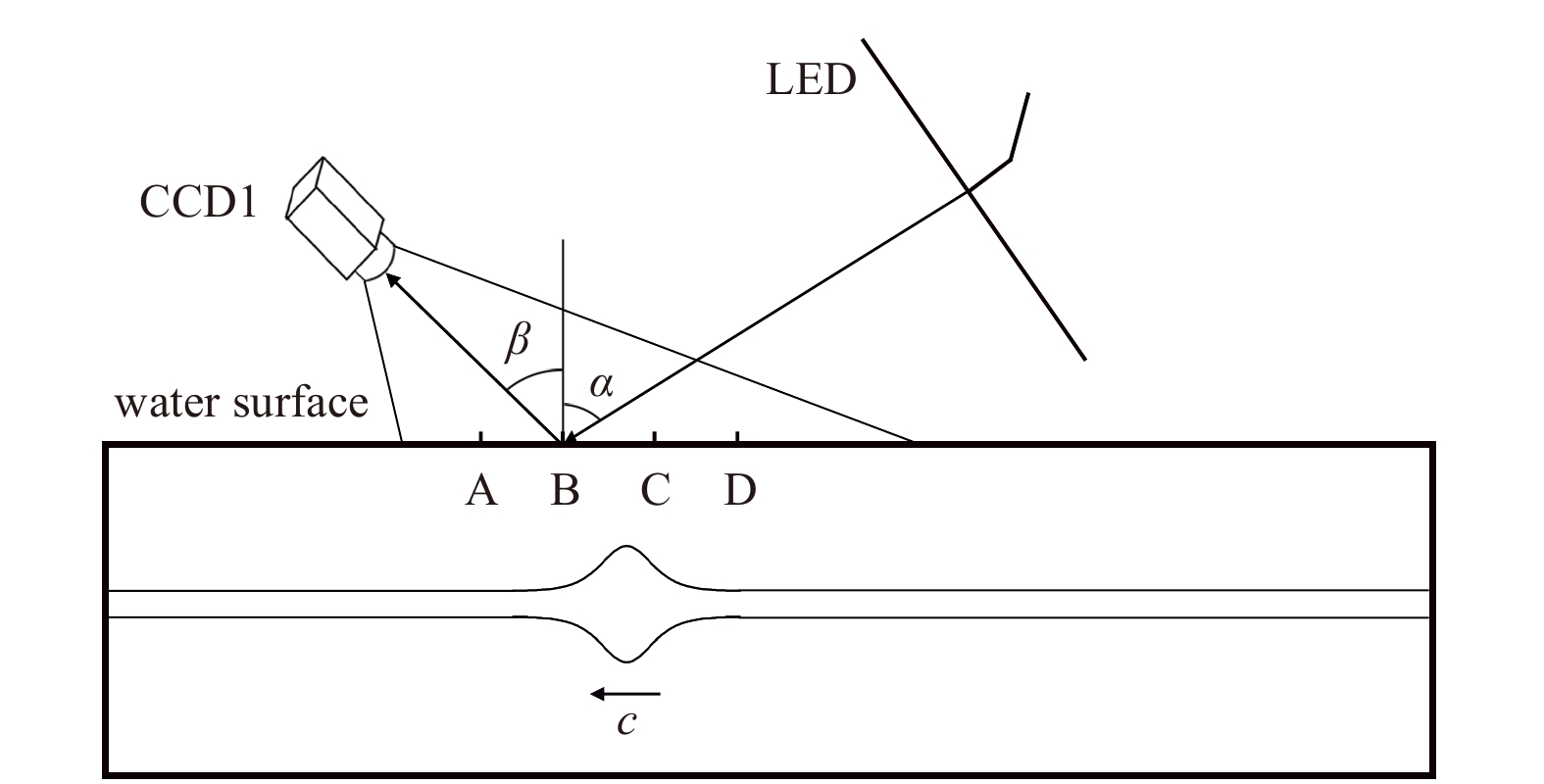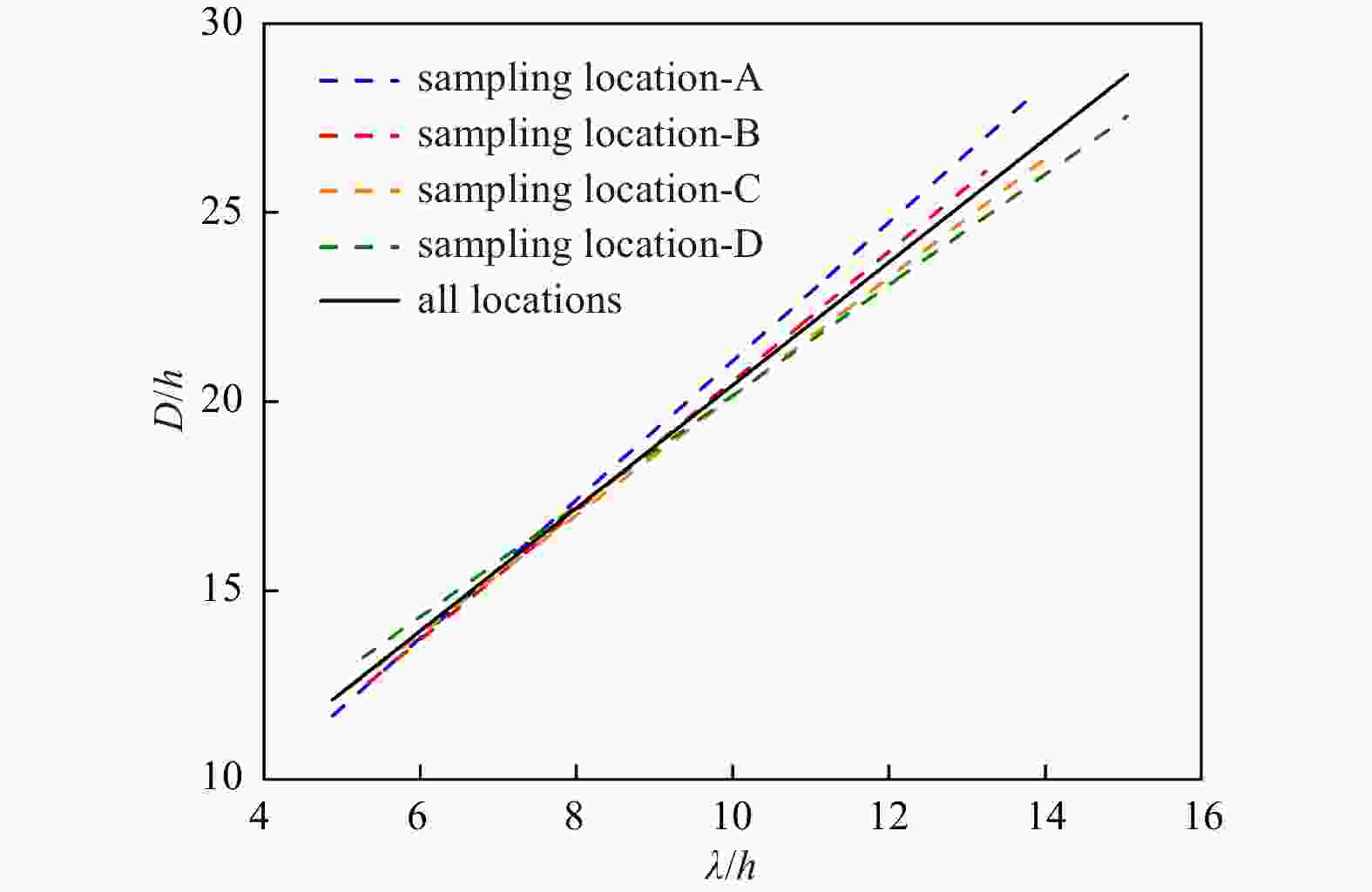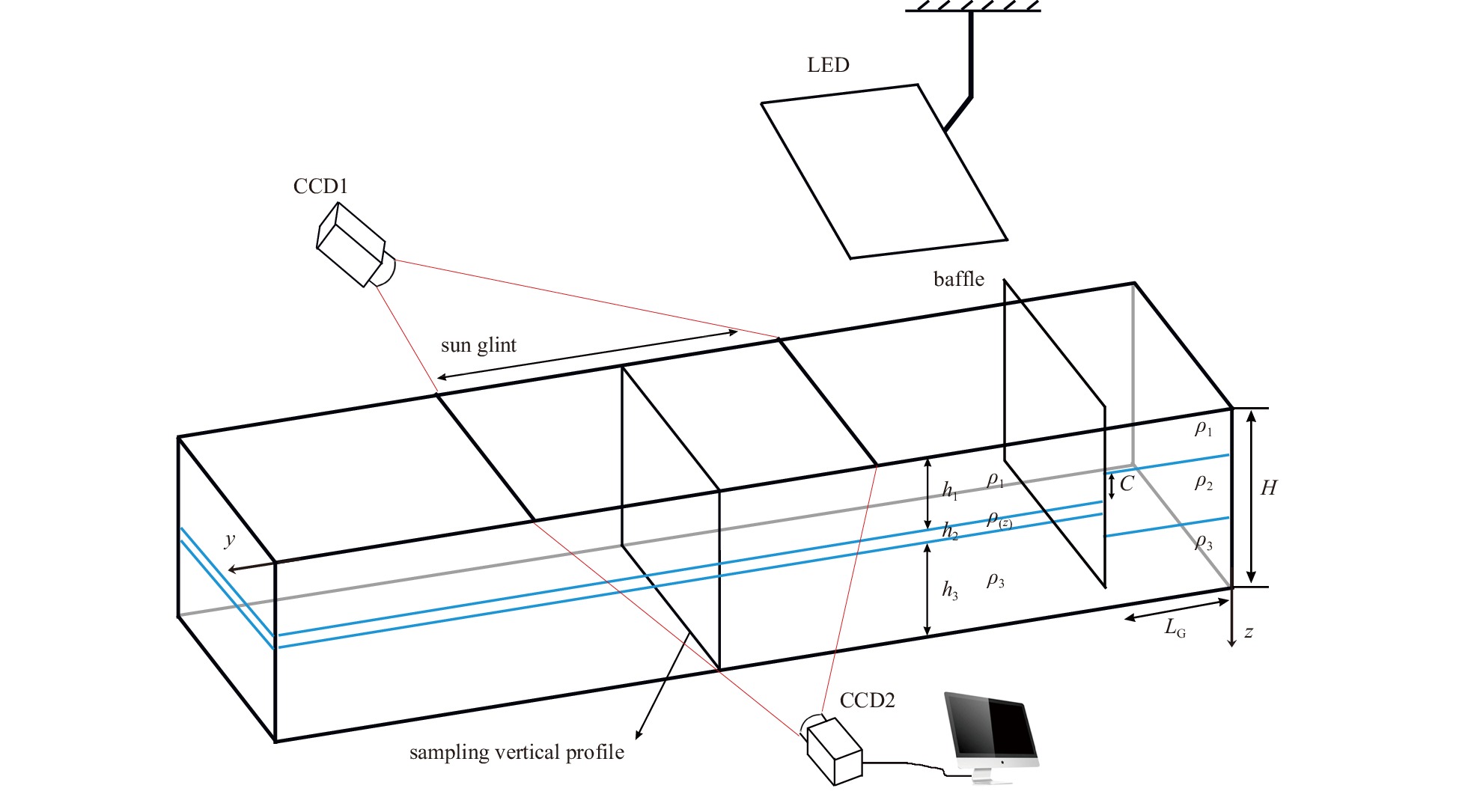Optical remote sensing image characteristics of large amplitude convex mode-2 internal solitary waves: an experimental study
-
Abstract: A series of experiments are designed to propose a new method to study the characteristics of convex mode-2 internal solitary waves (ISWs) in optical remote sensing images using a laboratory-based optical remote sensing simulation platform. The corresponding wave parameters of large-amplitude convex mode-2 ISWs under smooth surfaces are investigated along with the optical remote sensing characteristic parameters. The mode-2 ISWs in the experimentally obtained optical remote sensing image are produced by their overall modulation effect on the water surface, and the extreme points of the gray value of the profile curve of bright-dark stripes appear at the same location as the real optical remote sensing image. The present data extend to a larger range than previous studies, and for the characteristics of large amplitude convex mode-2 ISWs, the experimental results show a second-order dependence of wavelength on amplitude. There is a close relationship between optical remote sensing characteristic parameters and wave parameters of mode-2 ISWs, in which there is a positive linear relationship between the bright-dark spacing and wavelength and a nonlinear relationship with the amplitude, especially when the amplitude is very large, there is a significant increase in bright-dark spacing.
-
Figure 4. Gaofen-1 image taken north of Dongsha Islands on July 9, 2014. The blue box highlights a mode-1 internal solitary wave (ISW), and the red box highlights a mode-2 ISW. Profile data for the two ISWs are given in the insert figures. The mode-1 ISW shows dark-bright stripes, while the mode-2 ISW is the opposite.
Figure 5. Example diagram showing the matching of internal solitary wave (ISW) properties and profile curve of gray value of the associated remote sensing image. This time series was obtained from Experiment 12 (i.e., h1/H=0.288, C/H=4.29; the definitions of h1, H, C refer to Fig. 1). The left vertical axis represents the vertical sampling range in the tank, the right vertical axis represents the absolute gray value, and the horizontal axis represents the charge-coupled device camera shooting time. The blue boxes at the sampling time of about 30 s and 80 s represent the initial wave and reflected wave at the sampling location, respectively. The red curve is the profile curve of gray value recorded at the sampling location.
Figure 6. Wave parameter relationship diagrams for mode-2 internal solitary waves (ISWs). a. Relationship between average amplitude and initial step depth; b. relationship between average amplitude and average wavelength. The data points are the experimental data in this paper, and the solid black lines are the fitting of the experimental data. The black dotted lines are the experimental results of Brandt and Shipley (2014).
Figure 7. Schematic diagram of sampling location and imaging angle. A−D are all in the sun glint. Initial incident wave propagation from right to left.
$ \mathrm{\alpha } $ is the solar zenith angle, and$ \ {\beta } $ is the sensor zenith angle. LED: Light Emitting Diode; CCD: charge-coupled device.Figure 8. Bright-dark spacing versus wavelength in internal solitary wave optical remote sensing images. a. The relationship between the bright-dark spacing and the wavelength of the upper interface; b. the relationship between the bright-dark spacing and the wavelength of the lower interface; c. the relationship between the bright-dark spacing and the average wavelength.
Figure 9. Relationship between bright-dark spacing and wavelength at different angles. The least-square fitting results of four sampling locations A (blue dotted line), B (red dotted line), C (orange dotted line), and D (green dotted line), and the fitting results of all data (black solid line) are presented.
Table 1. Experimental parameters for the 26 individual experiments performed in the study
No. H/cm h1/H h/H C/h 1 40 0.475 0.028 5.33 2 40 0.475 0.031 6.43 3 40 0.375 0.014 8.85 4 40 0.375 0.024 5.24 5 40 0.375 0.031 5.69 6 40 0.338 0.015 8.20 7 40 0.338 0.037 3.39 8 40 0.338 0.041 4.26 9 40 0.313 0.021 8.33 10 40 0.313 0.039 3.19 11 40 0.288 0.025 6.97 12 40 0.288 0.029 4.29 13 40 0.288 0.039 3.22 14 40 0.263 0.026 6.73 15 40 0.238 0.026 6.73 16 40 0.238 0.039 3.19 17 40 0.213 0.024 7.33 18 40 0.213 0.028 4.48 19 46 0.417 0.017 9.21 20 46 0.417 0.038 5.75 21 46 0.370 0.021 7.18 22 46 0.370 0.038 5.71 23 46 0.315 0.024 4.57 24 46 0.315 0.034 4.52 25 46 0.261 0.018 5.92 26 46 0.261 0.029 5.17 Note: H: total fluid depth; h1: upper layer thickness; h: characteristic thickness of the interface; C: initial step depth. Table 2. Correlation coefficients between bright-dark spacing and wavelength at a series of locations along the tank
Location Solar zenith angle Sensor zenith angle Ru Rl Ra A 55.8° 51.3° 0.88 0.91 0.95 B 55.2° 53.3° 0.88 0.89 0.92 C 54.4° 55.5° 0.92 0.88 0.92 D 53.7° 57.5° 0.81 0.86 0.87 -
Alpers W. 1985. Theory of radar imaging of internal waves. Nature, 314(6008): 245–247. doi: 10.1038/314245a0 Apel J R, Ostrovsky L A, Stepanyants Y A, et al. 2007. Internal solitons in the ocean and their effect on underwater sound. The Journal of the Acoustical Society of America, 121(2): 695–722. doi: 10.1121/1.2395914 Brandt A, Shipley K R. 2014. Laboratory experiments on mass transport by large amplitude mode-2 internal solitary waves. Physics of Fluids, 26(4): 046601. doi: 10.1063/1.4869101 Carr M, Davies P A, Hoebers R P. 2015. Experiments on the structure and stability of mode-2 internal solitary-like waves propagating on an offset pycnocline. Physics of Fluids, 27(4): 046602. doi: 10.1063/1.4916881 Carr M, Stastna M, Davies P A, et al. 2019. Shoaling mode-2 internal solitary-like waves. Journal of Fluid Mechanics, 879: 604–632. doi: 10.1017/jfm.2019.671 Chen Liang, Xiong Xuejun, Zheng Quanan, et al. 2020. Mooring observed mode-2 internal solitary waves in the northern South China Sea. Acta Oceanologica Sinica, 39(11): 44–51. doi: 10.1007/s13131-020-1667-0 Davis R E, Acrivos A. 1967. Solitary internal waves in deep water. Journal of Fluid Mechanics, 29(3): 593–607. doi: 10.1017/S0022112067001041 Farmer D M, Smith J D. 1980. Tidal interaction of stratified flow with a sill in Knight Inlet. Deep-Sea Research Part A. Oceanographic Research Papers, 27(3–4): 239–246, IN5–IN10, 247–254, Helfrich K R, Melville W K. 2006. Long nonlinear internal waves. Annual Review of Fluid Mechanics, 38: 395–425. doi: 10.1146/annurev.fluid.38.050304.092129 Hennings I, Matthews J, Metzner M. 1994. Sun glitter radiance and radar cross-section modulations of the sea bed. Journal of Geophysical Research: Oceans, 99(C8): 16303–16326. doi: 10.1029/93jc02777 Honji H, Matsunaga N, Sugihara Y, et al. 1995. Experimental observation of internal symmetric solitary waves in a two-layer fluid. Fluid Dynamics Research, 15(2): 89–102. doi: 10.1016/0169-5983(94)00032-u Huang Xiaodong, Tian Jiwei, Zhao Wei. 2012. The behaviors of internal solitary waves near the continental shelf of South China Sea inferred from satellite images. Advanced Materials Research, 588–589: 2131–2135, Jackson C. 2007. Internal wave detection using the Moderate Resolution Imaging Spectroradiometer (MODIS). Journal of Geophysical Research: Oceans, 112(C11): C11012. doi: 10.1029/2007jc004220 Jackson C R, Alpers W. 2010. The role of the critical angle in brightness reversals on sunglint images of the sea surface. Journal of Geophysical Research: Oceans, 115(C9): C09019. doi: 10.1029/2009JC006037 Konyaev K V, Sabinin K D, Serebryany A N. 1995. Large-amplitude internal waves at the Mascarene Ridge in the Indian Ocean. Deep-Sea Research Part I: Oceanographic Research Papers, 42(11–12): 2075–2091, Lamb K G, Farmer D. 2011. Instabilities in an internal solitary-like wave on the Oregon shelf. Journal of Physical Oceanography, 41(1): 67–87. doi: 10.1175/2010JPO4308.1 Li Xiaofeng, Jackson C R, Pichel W G. 2013. Internal solitary wave refraction at Dongsha Atoll, South China Sea. Geophysical Research Letters, 40(12): 3128–3132. doi: 10.1002/grl.50614 Liu Antony K, Su Feng-Chun, Hsu Ming-Kang, et al. 2013. Generation and evolution of mode-two internal waves in the South China Sea. Continental Shelf Research, 59: 18–27. doi: 10.1016/j.csr.2013.02.009 Matthews J P, Aiki H, Masuda S, et al. 2011. Monsoon regulation of Lombok Strait internal waves. Journal of Geophysical Research: Oceans, 116(C5): C05007. doi: 10.1029/2010jc006403 Maxworthy T. 1980. On the formation of nonlinear internal waves from the gravitational collapse of mixed regions in two and three dimensions. Journal of Fluid Mechanics, 96(1): 47–64. doi: 10.1017/s0022112080002017 Mei Yuan, Wang Jing, Sun Lina, et al. 2017. Detection of mode-2 internal solitary waves in northern Dongsha atoll based on high resolution optical remote sensing. Acta Photonica Sinica (in Chinese), 46(10): 1001002. doi: 10.3788/gzxb20174610.1001002 Melsheimer C, Kwoh L K. 2001. Sun glitter in spot images and the visibility of oceanic phenomena. In: Proceedings of the 22nd Asian Conference on Remote Sensing. Singapore: Asian Conference on Remote Sensing, 870–875 Osborne A R, Burch T L. 1980. Internal solitons in the Andaman Sea. Science, 208(4443): 451–460. doi: 10.1126/science.208.4443.451 Qian Hongbao, Huang Xiaodong, Tian Jiwei. 2016. Observational study of one prototypical mode-2 internal solitary waves in the northern South China Sea. Haiyang Xuebao (in Chinese), 38(9): 13–20. doi: 10.3969/j.issn.0253-4193.2016.09.002 Raju N J, Dash M K, Dey S P, et al. 2019. Potential generation sites of internal solitary waves and their propagation characteristics in the Andaman Sea—a study based on MODIS true-colour and SAR observations. Environmental Monitoring and Assessment, 191(3): 809. doi: 10.1007/s10661-019-7705-8 Ramp S R, Yang Y J, Reeder D B, et al. 2012. Observations of a mode-2 nonlinear internal wave on the northern Heng-Chun Ridge south of Taiwan. Journal of Geophysical Research: Oceans, 117(C3): C03043. doi: 10.1029/2011JC00766 Salloum M, Knio O M, Brandt A. 2012. Numerical simulation of mass transport in internal solitary waves. Physics of Fluids, 24(1): 016602. doi: 10.1063/1.3676771 Shen Hui, Perrie W, Johnson C L. 2020. Predicting internal solitary waves in the Gulf of Maine. Journal of Geophysical Research: Oceans, 125(3): e2019JC015941. doi: 10.1029/2019jc015941 Stamp A P, Jacka M. 1995. Deep-water internal solitaty waves. Journal of Fluid Mechanics, 305: 347–371. doi: 10.1017/S0022112095004654 Sun Lina, Zhang Jie, Meng Junmin. 2019. A study of the spatial-temporal distribution and propagation characteristics of internal waves in the Andaman Sea using MODIS. Acta Oceanologica Sinica, 38(7): 121–128. doi: 10.1007/s13131-019-1449-8 Wang Jing, Zhang Meng, Mei Yuan, et al. 2021. Study on inversion amplitude of internal solitary waves applied to shallow sea in the laboratory. IEEE Geoscience and Remote Sensing Letters, 18(4): 577–581. doi: 10.1109/LGRS.2020.2985123 Wu Jin. 1969. Mixed region collapse with internal wave generation in a density-stratified medium. Journal of Fluid Mechanics, 35(3): 531–544. doi: 10.1017/s0022112069001261 Yang Ying Jang, Fang Ying Chih, Chang Ming-Huei, et al. 2009. Observations of second baroclinic mode internal solitary waves on the continental slope of the northern South China Sea. Journal of Geophysical Research: Oceans, 114(C10): C10003. doi: 10.1029/2009jc005318 Yang Y J, Fang Y C, Tang T Y, et al. 2010. Convex and concave types of second baroclinic mode internal solitary waves. Nonlinear Processes in Geophysics, 17(6): 605–614. doi: 10.5194/npg-17-605-2010 Yang Ying-Jang, Tang Tswen Yung, Chang Ming-Huei, et al. 2004. Solitons northeast of Tung-Sha Island during the ASIAEX pilot studies. IEEE Journal of Oceanic Engineering, 29(4): 1182–1199. doi: 10.1109/joe.2004.841424 Zheng Quanan, Yuan Yeli, Klemas V, et al. 2001. Theoretical expression for an ocean internal soliton synthetic aperture radar image and determination of the soliton characteristic half width. Journal of Geophysical Research: Oceans, 106(C12): 31415–31423. doi: 10.1029/2000JC000726 -




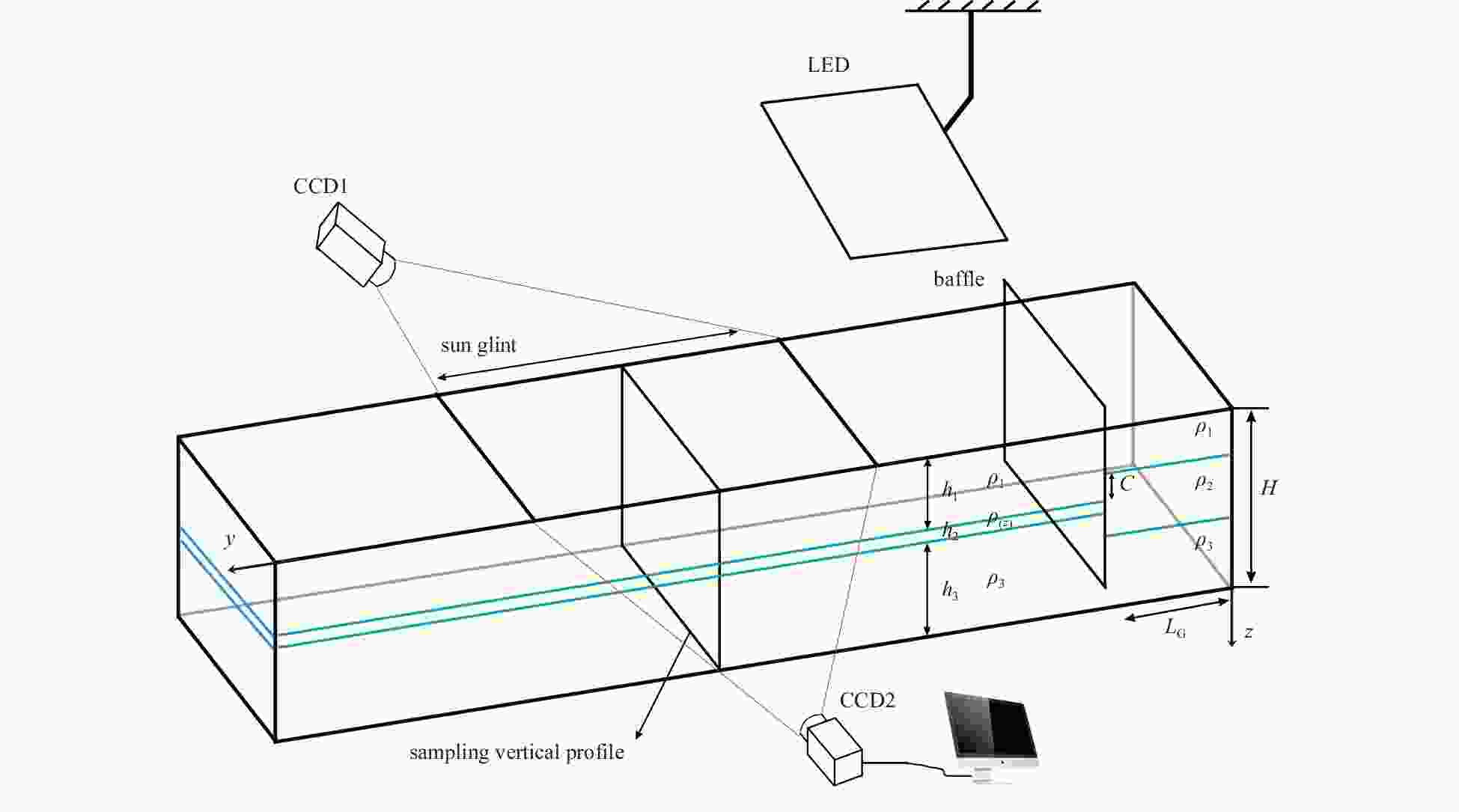
 下载:
下载:


